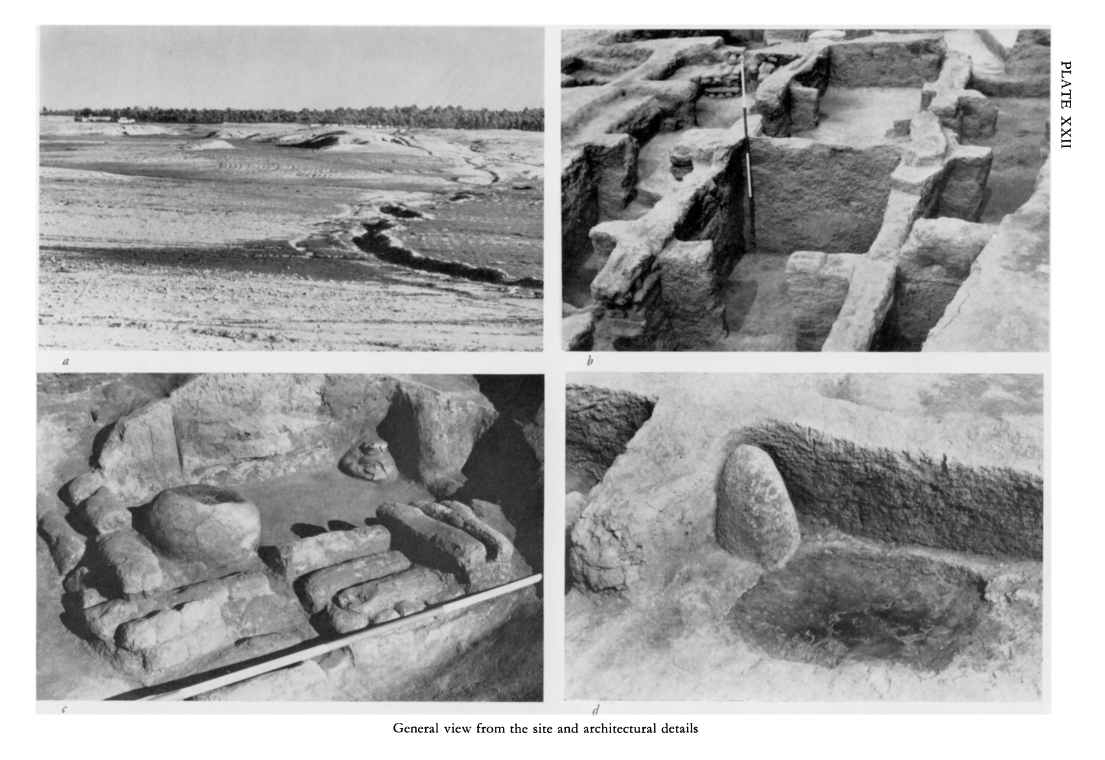|
Other Archaeological Sites / The Neolithic of the Levant (500 Page Book Online) Chalocolithic Choga Mami
The excavations at Choga Mami, east of Baghdad and not far from the Iranian border, were begun in December 1967 and were finished in February 1968. The surviving occupation levels at Choga Mami, as far down as we have excavated, represent a large village or small town of the Samarra Period (circa 5000 BC). A very extensive collection of surface material has not produced anything that is certainly earlier, although there are some Jarmo flints and pottery (circa 6750 BC) on nearby mounds. On the other hand there was evidently later occupation, the evidence for which has been lost by erosion. The latest level of which vestiges remain yielded pottery of transitional Samarra/Hajji Muhammad (circa 4900-4300 BC) type. Sunk through this from an even higher occupation level that has totally disappeared was a well containing sherds of late Halaf (circa 5200 BC) polychrome pottery of the best Arpachiyah type together with other hitherto unknown but approximately contemporary material, probably of Iranian origin. Elsewhere on the mound another late well produced Hajji Muhammad and later Ubaid (circa 3500 BC) types and a large pit contained a consistent range of Early Dynastic material, probably ED I-II (2900-2600 BC) (1). One important aspect of the site therefore is the evidence that it yields for chronological relationships between North and South Mesopotamian cultures, at least in the area of Mandali, and for connections with Iran. Our first impression of this evidence is that the culture represented by Samarra pottery is, at least at Choga Mami, quite distinct from Hassuna (circa 5600 BC). We found no Hassuna pottery and it is rare at the closely comparable site of Tell es-Sawwan near Samarra. It seems that Hassuna is essentially a culture of the rain-fed northern plain of Mesopotamia, while Samarra flourished in central Mesopotamia on the fringes of the alluvium (ibid). Our Samarra material also showed relationships with the true southern cultures of the Eridu (circa 5300-5000 BC) /Hajji Muhammad/Ubaid sequence. One sherd of early Eridu ware (Eridu XVII) was stratified in a Samarra level and, as we have noted, our latest surviving occupation level produced pottery which appears to be transitional between Samarra and Hajji Muhammad. True Hajji Muhammad and Ubaid came later, in levels that have now been eroded, as did late Halaf material. Unfortunately these two groups of material, though homogeneous in themselves, cannot be chronologically related to one another since they derive from the fill of later wells (ibid). A most important piece of evidence bearing on the relation between Samarra and the southern cultures is the discovery in true Samarra context of a series of broken terra-cotta female figurines with heads rendered in a naturalistic manner, but with an elongated profile and hair style which in its most pronounced form is an obvious lineal antecedent of the Ubaid "lizard-headed" figurines from Ur. We would therefore suggest as a working hypothesis that the prosperous Samarra settlement at Choga Mami represents an intermediate stage between the early rain-fed agriculture of the northern plain, as typified by Hassuna, and the full efflorescence of the Ubaid economy in the south, which must have been based on large-scale irrigation (ibid). Irrigation canals were introduced during the Choga Mami phase approximately contemporary with early examples in the Mandali Plain to the northwest at the site of Choga Mami itself. Well over 90% of all subsequent sites on the Deh Luran Plain in Iran are suggested to have been located on canals ... The introduction of irrigation, new types of grain, foreign ceramic styles and domestic cattle are all located in the Choga Mami phase, a late manifestation of the Samarran Period in lowland Mesopotamia. This chronological identification thus also suggests the source of these innovations: migration from the lowlands ... The Chogha Mami phase had a few small village clusters with small irrigated areas where people grew wheat and barley; herded sheep, goats and some cows; and hunted gazelles and other wild fauna. Some canals reached more than five kilometers in length, which would require the cooperative labor of larger groups ...
(1) EXCAVATIONS AT CHOGA MAMI IRAQ by David Oates (PDF)
|
